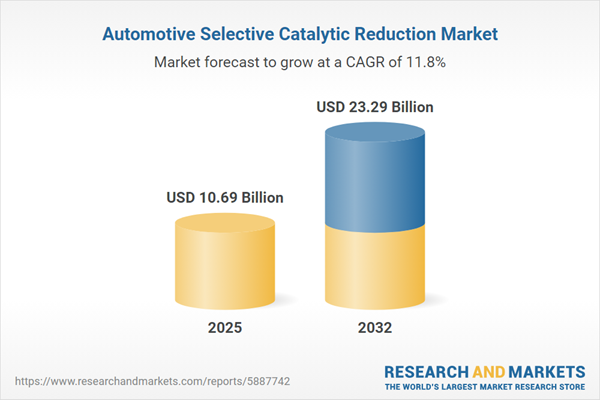Speak directly to the analyst to clarify any post sales queries you may have.
The automotive selective catalytic reduction market is at the center of regulatory transformation as organizations face rising compliance expectations and operational uncertainty. Senior executives are prioritizing investments in proven emissions technology, resilient supply chain relationships, and scalable compliance capabilities to secure consistent performance and maintain a competitive edge.
Market Snapshot: Automotive Selective Catalytic Reduction Market
The automotive selective catalytic reduction market is expanding rapidly, with a current valuation of USD 9.54 billion in 2024 and expected year-on-year growth to USD 10.69 billion by 2025. Long-term projections estimate the market will achieve USD 23.29 billion by 2032, underpinned by a robust 11.80% CAGR. This growth trajectory reflects the increasing global investment in advanced selective catalytic reduction systems, driven by more stringent emissions legislation and rising adoption among automotive manufacturers, commercial transport operators, and fleet owners. Innovations in catalyst efficiency, digitalized system control, and compliance processes are enabling organizations to adapt swiftly to evolving environmental requirements and future-proof their operations.
Scope & Segmentation
- Vehicle Types: Solutions are engineered for heavy commercial vehicles, light commercial vehicles, and passenger cars, addressing differences in emission profiles and compliance criteria across regulated markets and varying operational needs.
- Product Types: The market includes NOx sensors, electronic control units, catalyst modules, and urea dosing units, each developed to optimize emissions reduction and ensure reliable system integration across diverse automotive platforms.
- Fuel Types: SCR technologies support diesel, gasoline, and hybrid engines, adjusting to multiple fuel compositions and maintenance requirements, thus providing flexibility for global fleet management strategies.
- Technology: Both active SCR configurations and passive systems are implemented, enabling organizations to tailor emissions control approaches to specific compliance targets and fleet characteristics.
- Sales Channels: Original equipment manufacturer (OEM) channels provide integration during vehicle production, while aftermarket solutions facilitate retrofitting and systems upgrades for in-service fleets that require continued regulatory adherence.
- Geographies: Adoption patterns and technology deployment strategies vary across the Americas, Europe, the Middle East & Africa, and Asia-Pacific. Regional regulatory approaches and infrastructure maturity shape implementation models and supplier partnerships.
- Key Countries: Market adoption and supplier strategies are especially influenced by regulatory climates in the United States, Canada, Mexico, Brazil, United Kingdom, Germany, France, China, India, Japan, and Australia, reflecting both trend initiation and early adoption of advanced SCR technologies.
- Leading Companies: Industry advancements are driven by Johnson Matthey plc, BASF SE, Haldor Topsoe A/S, Clariant AG, Umicore SA, Evonik Industries AG, Albemarle Corporation, W. R. Grace & Co., NIPPON SHOKUBAI Co., Ltd., and China Petroleum & Chemical Corporation. These organizations lead in catalyst design and system engineering, spearheading next-generation SCR deployments globally.
Key Takeaways for Senior Decision-Makers
- Integrated SCR platforms offer scalable compliance capabilities and support ongoing alignment with new regulatory standards by leveraging connected diagnostic and monitoring tools.
- Collaboration with specialized suppliers provides risk resilience, enhancing supply stability even during periods of volatility in input materials and logistics.
- Strategic component sourcing, matched to operational contexts and fuel types, results in improved lifecycle economics and safer, more consistent operational outcomes across vehicle classes.
- Enduring investments in next-generation catalyst materials and robust system designs extend asset usability, supporting cross-regional operations where emission compliance varies.
- Phased adoption and regional partnerships enable forward-looking regulatory adaptation and allow companies to proactively manage long-term transition risks.
Tariff Impact: Navigating Trade and Cost Pressures
Input tariffs are contributing to higher costs for essential SCR system components, such as steel, aluminum, and advanced catalysts. Automotive organizations are responding by localizing production and diversifying supplier bases, reducing exposure to cross-border disruptions and optimizing inventory management. Flexible, modular SCR architectures facilitate rapid adaptation to market shifts and evolving regulatory frameworks. Protecting intellectual property remains a core tactic for maintaining competitive differentiation amid ongoing adjustment to global trade policy environments.
Methodology & Data Sources
This report draws on expert executive interviews, comparative technology benchmarking, and extensive review of global supply chain trends. Scenario modeling and comprehensive data triangulation provide a decision-ready framework specifically tailored to the needs of executives assessing SCR investments and compliance management.
Why This Report Matters
- Directly connects dynamic regulatory trends to SCR technology evolution, equipping leaders with tools to streamline operations while achieving compliance targets.
- Delivers actionable guidance for risk anticipation, global regulatory alignment, and effective adoption of new emission control technologies across diverse automotive fleets.
- Facilitates confident, informed decision-making for management and engineering teams as they navigate shifting emission control mandates.
Conclusion
Selective catalytic reduction is foundational for effective fleet emissions management. By aligning sourcing practices, embracing technology innovation, and fostering industry collaboration, organizations can build resilience and maintain leadership amid a rapidly shifting regulatory landscape.
Additional Product Information:
- Purchase of this report includes 1 year online access with quarterly updates.
- This report can be updated on request. Please contact our Customer Experience team using the Ask a Question widget on our website.
Table of Contents
3. Executive Summary
4. Market Overview
7. Cumulative Impact of Artificial Intelligence 2025
Companies Mentioned
The companies profiled in this Automotive Selective Catalytic Reduction market report include:- Johnson Matthey plc
- BASF SE
- Haldor Topsoe A/S
- Clariant AG
- Umicore SA
- Evonik Industries AG
- Albemarle Corporation
- W. R. Grace & Co.
- NIPPON SHOKUBAI Co., Ltd.
- China Petroleum & Chemical Corporation
Table Information
| Report Attribute | Details |
|---|---|
| No. of Pages | 181 |
| Published | October 2025 |
| Forecast Period | 2025 - 2032 |
| Estimated Market Value ( USD | $ 10.69 Billion |
| Forecasted Market Value ( USD | $ 23.29 Billion |
| Compound Annual Growth Rate | 11.8% |
| Regions Covered | Global |
| No. of Companies Mentioned | 11 |








